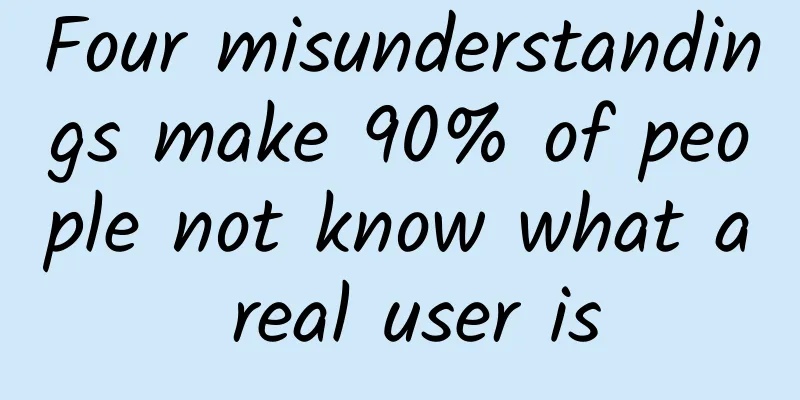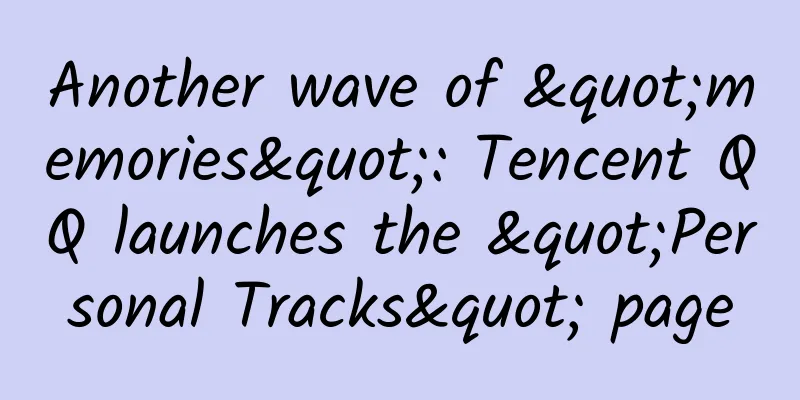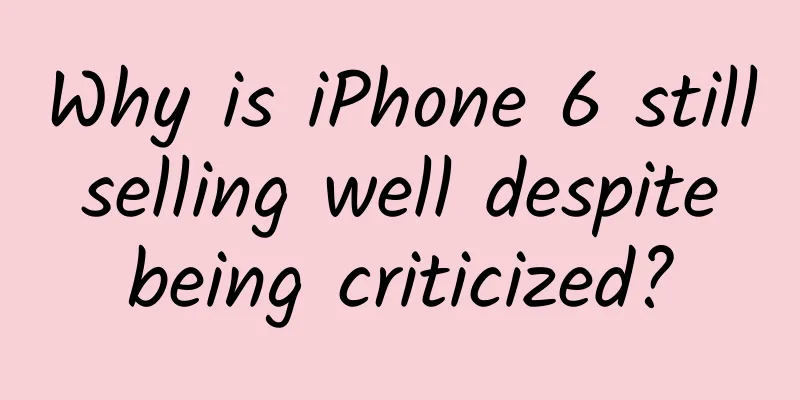Four misunderstandings make 90% of people not know what a real user is

|
A company that claimed to have tens of millions of users survived for two or three years with investment money. When it started to monetize its users, it was shocked to find that its revenue was only tens of thousands of yuan. Everyone was shocked. What is the problem? I guess many people don't know. Some people say it is a problem of monetization method, some say it is a problem of strategy. In fact, the most fundamental problem is the user problem. There is an obvious reason for this problem, that is, the so-called users are not called users, or are not users at all. For a long time, many people have made many misunderstandings about the identification of user characteristics, so that they treat users who are not users as users and do a lot of meaningless work. In the field of today's Internet entrepreneurship, there are many exaggerated users. Let me give a few examples. Mistakenly took pv as user I once met a person who runs a gaming community. He talked about the community activities we do, and there are hundreds of millions of PV users. Sometimes there are hundreds of millions of users in one activity. When I heard this, I thought that with such a large number of users, the income must be at least the same as WeChat. When I asked him how they make money, he said that there is no profit, but there is investment. This situation is a case of mistaking PV for users, and constantly promoting it to the outside world. In the end, I was shocked and admired him very much. So I downloaded his App and took a look. I was dumbfounded. The activities he mentioned are similar to h5 activity pages, such as a small survey, a constellation vote, which can be shared to Moments and Weibo, and then these shared pages will generate a lot of PV... and then there is nothing else. In fact, these are not users, they are just visitors, or even not even visitors. 90% of these users cannot bring revenue to the company. They are just WeChat users, or just Weibo users. If you count them according to independent IP addresses, and then count them according to truly activated users, and then count them according to loyal users... I think there are not many of them. If it comes to monetization one day in the future, there will probably be even fewer. Mistaking downloads for users I saw an App post a PR article before, celebrating that the download volume of a certain App exceeded 50 million. I laughed after reading it. The download volume is really a very imaginary data. You can use a simple program to swipe it, which is probably a matter of ten minutes, or you can find someone in the backend of the program to change the number. Of course, there are even more bizarre promotional articles, where there are more active users than registered users. An App has 100 registered users and 200 active users, and it is also looking for venture capital investment. I don’t know how the logic of this user is calculated. There are many such situations, mainly unprofessional or for the purpose of fooling people. If your download volume is really 50 million, even if it is the user’s download volume, there is still a long way from download volume to user. The user may accidentally click and be counted as downloaded, but in fact the user did not download it, or the user downloaded it but did not download it, and it was interrupted in the middle, which may also be counted as a download. There are also users who downloaded it but did not install it for various reasons, or even if they installed it, the installation failed, or there are various reasons. We have encountered too many of them. The conversion rate from downloads to users may be as low as 1% depending on the size of the software package, the quality of the software, and registration restrictions. If you calculate the daily and monthly active users based on 1%, only a handful of users will actually stay. Therefore, don’t always think that apps with tens of millions of downloads are just empty numbers. Mistaking the amount of brushing for the user With the popularity of apps, app promotion has also become popular, and then many businesses that use fake traffic and users have also become popular. Many people know that it is fake, but they still insist on doing it. Maybe it is for work and to show it to the boss. In fact, sometimes the boss also knows that it is fake. It is probably for investors to see, and then the investors show it to the LP. Finally, they successfully earn income from the LP. Then the bubble comes, the company goes bankrupt, and everyone starts a business in another field. Some people take listing and cashing out as their goal, while others want to make the company a century-old company. This is the difference between fake bosses and real bosses. So there are a lot of fake users, which is too boring. The key is to treat these users as users and promote successful experiences and methods everywhere. This is really misleading. Mistaking active users for users Now many companies use many radical methods for users, such as sending vouchers, lucky draws, pushing prizes, sending red envelopes, etc., all for the purpose of attracting users, but are they really attracting users? As people in the industry say, most of them are just trying to get free money, not real users. For example, a few days ago, I saw a certain express car doing ground promotion and recruiting drivers. The method is that anyone can participate. Just fill in the license plate number and name, and you will be a car owner or a user. After a while, you will see a group of people gathering to receive prizes. Can car owners promoted in this way be considered users? Can they serve future passengers well? We need to put a question mark. Another thing is that I saw a carpooling app doing ground promotion at a national conference, drawing red envelopes, and giving red envelopes after installing an App, and then basically all users who have installed it uninstalled it. In addition, the method of pushing apps by a certain mailbox is even more bizarre. As soon as you open the email, you will receive a lucky draw event, and then tell you that you have won a lucky draw code, and then tell you that if you want to see if you have won a prize, you have to download the client. Will users pay for such playing with users? It is unknown. … Of course, there are still many people who mistakenly believe that they have a lot of users, but in fact, those are all fake. When you are ready to cash out one day, you will find that the so-called users you have burned tens of millions or even hundreds of millions of dollars to bring you can only bring you tens of thousands of income a day, which is not even enough to pay for one employee. Therefore, real users are not so easy to get, but there is a slow accumulation process. Look at those short-lived apps such as Face Meng and Zu Ji, which instantly gained a large number of users, and you will know how vulnerable their so-called users are. Of course, there are many more. If there is no so-called venture capital support, how many apps can survive? It is estimated that the result is vulnerable. So, what is a real user? Through the case we can find the following three characteristics. Users who can generate cash I once saw a joke online about borrowing money. Many people said that they had a wide network of contacts, but when something went wrong, no one helped them and no one was willing to lend them money. In fact, this method can also be used to measure users. That is, when you need to monetize, the users who are willing to pay are the real users. These users have a certain consumption capacity and economic income and can bring income to the product. If you have 1 million users, when you need to monetize, 500,000 users pay for you through monetization, then your real users are 500,000, and the monetization rate is 50%. Does this mean that your users are real users? If another platform has 10 million users, and when monetizing, only 100,000 people are willing to pay, then the monetization rate is only 1%, which only means that you only have 100,000 users. Therefore, users who can generate monetization for the product are your real users. Customers who are loyal to the product It means that users have a certain degree of loyalty to the product and will not change their choices due to changes in the external environment. Such users recognize the product and are willing to use it all the time. For example, a user who likes to buy Xiaomi will still choose Xiaomi even if someone sells him a Coolpad phone. This is user loyalty, and such users are your users. Users who have contributed to the product's reputation This type of user recognizes the value of the product and is willing to promote the product for free, which can bring word-of-mouth effect to the product. For example, I have recommended more than a dozen users to Uber because its price is really cheap and the speed of calling a car is fast. So I am an Uber user. So the real users are those who recognize the value of the product, have a certain degree of loyalty to the product, can contribute to the word-of-mouth effect of the product, and are willing to consume the product. In this era of popular entrepreneurship, many entrepreneurs keep promoting tens of millions of users, but they survive by relying on venture capital. After three or five years, without financial support, they can only sell at a low price. This is good. The bad is to lay off employees, reduce the scale, and finally disappear. Only focusing on the number of users, not the quality of users, will end up being a bubble. So don't look at the number of users, look at the quality of users, the monetization rate of users, and the value of users. As a winner of Toutiao's Qingyun Plan and Baijiahao's Bai+ Plan, the 2019 Baidu Digital Author of the Year, the Baijiahao's Most Popular Author in the Technology Field, the 2019 Sogou Technology and Culture Author, and the 2021 Baijiahao Quarterly Influential Creator, he has won many awards, including the 2013 Sohu Best Industry Media Person, the 2015 China New Media Entrepreneurship Competition Beijing Third Place, the 2015 Guangmang Experience Award, the 2015 China New Media Entrepreneurship Competition Finals Third Place, and the 2018 Baidu Dynamic Annual Powerful Celebrity. |
<<: Those "little tricks" hidden in variety shows and reality shows
>>: Can Google Play really pave the way for China with money?
Recommend
What are the functions of the Guangzhou WeChat Beauty Mini Program? How much does it cost to develop a skin care product mini program?
The most profitable industry nowadays is the &quo...
Apple releases iOS 17.0.2 official version again
Apple just pushed out iOS 17.0.2 last Friday, whi...
watchOS 2 beta 3 officially released to developers
[[139584]] Today, Apple released the third beta o...
An underground tunnel was found in a giant crater on the moon, which may become an ideal site for a lunar base | Expo Daily
There may be a tunnel leading underground in the ...
It is difficult to create a road without a road: the legendary discovery journey of green fluorescent protein
Green fluorescent protein can form chromophores b...
Which promotional platforms are suitable for Father’s Day marketing ads?
June 16th is Father's Day, and there are stil...
Meituan responded to the cancellation of Alipay. Why did Meituan cancel Alipay again?
Meituan responds to cancellation of Alipay July 3...
Where can I get advertising for my personal Douyin account?
As we all know, once a Douyin account has a certa...
An asteroid may hit the Earth in 7 years? Don't be afraid, it's not the first time...
Editor: Dong Xiaoxian Reviewer: Zhang Chao, Li Pe...
When driverless driving becomes a risk in Tesla's eyes, can cars really say goodbye to steering wheels in three years?
Not long ago, Tesla CEO Elon Musk posted a messag...
12 Industry Trends of “Internet+”
At this year's two sessions, Premier Li Keqia...
For the first time in the world, how difficult is it to "dig soil" on the back of the moon?
On May 3, 2024, the Chang'e-6 probe boarded t...
A box costs more than 400 yuan, and one dose lasts for 5 days? The new "magic flu drug" Mabaloxavir is popular, and doctors warn
The proportion of influenza A has just dropped, a...
A brief analysis of the three elements of copywriting: background, conflict, and answer
It’s always good to know some copywriting skills....
Do foods labeled “0 calories” really have no energy at all?
As the weather warms up, have the weight loss arm...









